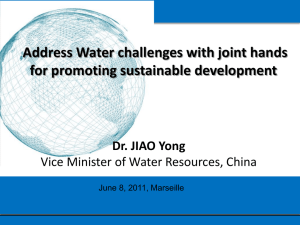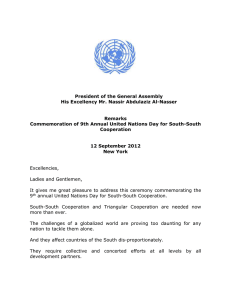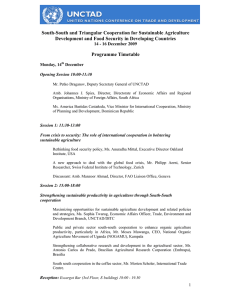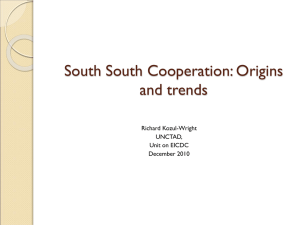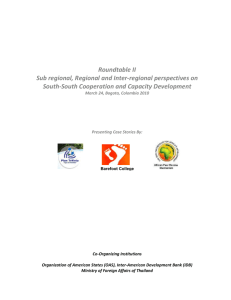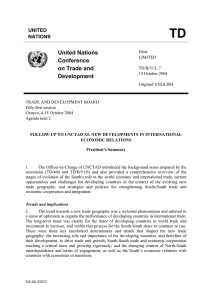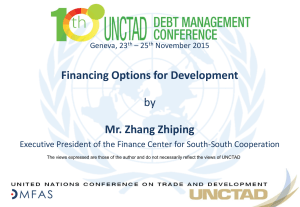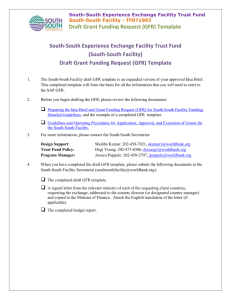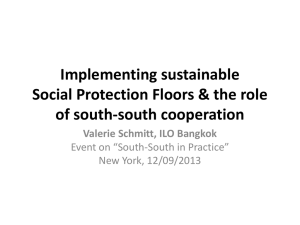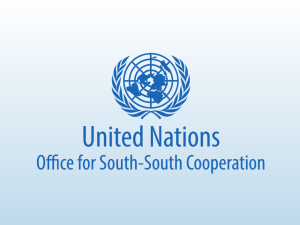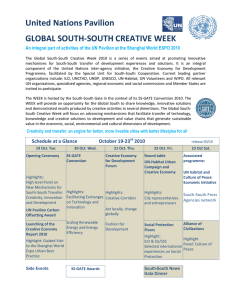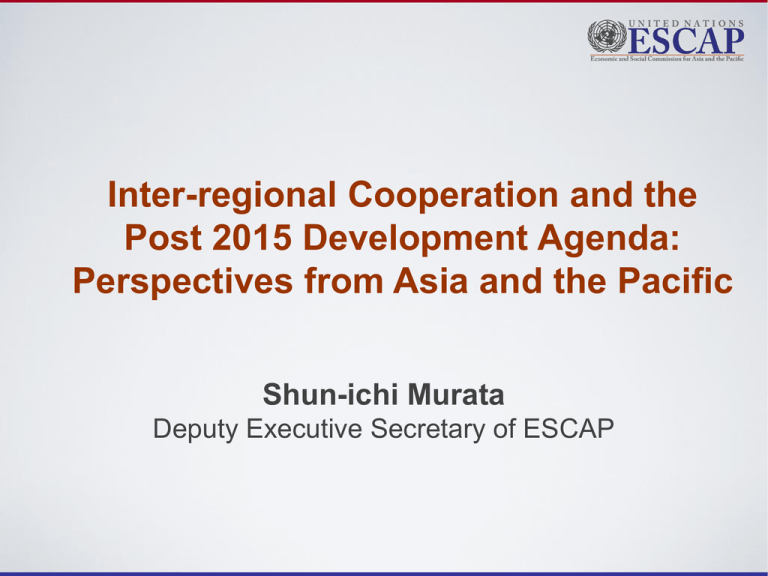
Inter-regional Cooperation and the
Post 2015 Development Agenda:
Perspectives from Asia and the Pacific
Shun-ichi Murata
Deputy Executive Secretary of ESCAP
UN Charter
Article 55:
The United Nations shall promote:
Higher standards of living, full employment, and conditions of
economic and social progress and development;
Solutions of international economic, social, health, and related
problems; and international cultural and educational
cooperation, and;
Universal respect for, and observance of, human rights and
fundamental freedoms for all without distinction as to race, sex,
language, or religion.
Article 56:
All Members pledge themselves to take joint and separate action
in co-operation with the Organization for the achievement of the
purposes set forth in Article 55.
Rise of Asia-Pacific
Real per capita
income
Sri Lanka
Philippines
India
Indonesia
China
Japan
USA
UK
1947
(USD)
91
88
43
35
23
Less than 100
1,269
660
2012
(USD)
1,884
1,501
1,107
1,732
3,348
36,938
43,063
37,849
Source: Economic and Social Surveys of Asia and the Pacific
Most dynamic region
Real GDP growth by regions of the world
a: Members of the Economic Commission Europe
The South rises
Actual and projected shares of world economic output, 1990, 2010 & 2030
Per cent of world GDP, PPP (1990 Geary-Kheamis dollars)
South-South trade + other
exchanges rising with growing synergies
South-South share in total world trade and southern trade, 1995-2011
Per cent of merchandise trade exports
Inter-regional South-South trade
has also expanded rapidly in recent years
Developing Africa’s exports
Vibrant South-South trade in
services and investment flows
Share of Outward FDI Flows from Developing Countries in Global FDI Flows
Rising South-South
development assistance
Development assistance flows from non-DAC donors
Millions of current USD
Rising South-South potential
for financial cooperation
Total international reserve assets, 1990-2012
Millions of SDRs
Institutions for cooperation
Global level country groupings
Non-aligned Movement and G-77+China
g7+ Group of Fragile States
BRICS
Country groupings in Asia and the Pacific
ASEAN
SAARC
Economic Cooperation Organization
Shanghai Cooperation Organization
Pacific Islands Forum
Challenge for ESCAP and other regional commissions
Building on the existing efforts in South-South cooperation
Fostering cooperation and coordinated action among sub-regional
groupings, particularly in the context of the UN post-2015
Development Agenda
Development challenges
Economic insecurity
828 million people live on less than $1.25 a day
About 900 million live on between $1.25 and $2 a day
563 million are undernourished
1.1 billion are in vulnerable employment
Unsustainable use of natural resources
Adverse environmental impacts
Increased emissions of greenhouse gases
Volatility in commodity prices
Lack of investment in infrastructure
Energy, transport and virtual connectivity, urban development
Financing requirement for the region is $ 8 trillion.
Vulnerability to natural disasters
Asia-Pacific accounted for 80% of global losses due to disasters in
2011
The challenge of inequality
The challenge of connectivity
Many Asia-Pacific-wide agreements contribute to increasing
physical connectivity
Major challenges of connectivity are in energy, water,
communication and people-to-people
Key issue for Pacific Island Countries and Landlocked
developing countries of Central Asia
“Regional Connectivity for Shared Prosperity” is the theme of
the Commission session in 2014
Connectivity is a key determinant of trade and economic
development, and of regional and inter-regional cooperation
ESCAP and the Post-2015
Development Agenda
Assisting countries in setting a Post-2015 Agenda
Stock-taking: assess progress towards internationally agreed
goals, including MDGs
Organizing inclusive high-level consultations at the regional
and subregional levels
Means of implementation
Development and implementation of regional agreements on:
exchange of experiences, technology transfer, regional
integration and financing of development
Providing evidence-based policy options
Complementing and connecting global and country-level
programmes of the United Nations
Regional approaches to technical cooperation
Challenges for interregional
cooperation
High trade costs of inter-regional trade because of
geographical distance and poor connectivity, tariff and
non-tariff barriers
Few preferential arrangements to promote interregional
trade
The need to devise means for exploiting full potential of
South-South Cooperation
Danger of replicating centre-periphery type of economic
relations between more advanced developing countries
and LDCs
Towards a policy framework
for South-South cooperation
A policy framework is needed for:
Institutional promotion of inter-regional trade and investments
Implementing GSTP Sao Paolo Round
Extending the coverage and scope
Extending the scope of GSTP to trade in service
South-South investment promotion and protection to facilitate FDI flows
Special promotion of greenfield South-South FDI flows in LDCs
Adoption of Duty-Free Quota-Free (DFQF) schemes for LDCs to enable
them to export value-added products
Exchanging good practices in South-South cooperation
Developing a set of voluntary guidelines to shape South-South
investments and economic relations in an equitable and sustainable
manner
Major emerging countries leading by example in terms of good practices
Thank you!
Please visit:
www.regionalcommissions.org
to download presentation

